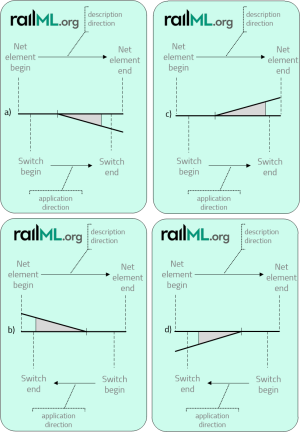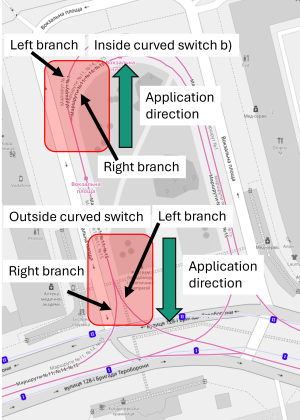Dev:Railway switch curve: Difference between revisions
Jump to navigation
Jump to search
| [checked revision] | [checked revision] |
No edit summary |
(added table) |
||
| Line 12: | Line 12: | ||
! Case !! leftBranch/@radius !! rightBranch/@radius | ! Case !! leftBranch/@radius !! rightBranch/@radius | ||
|- | |- | ||
| Ordinary switch a) || 0 || | | Ordinary switch a) || 0 || 300 | ||
|- | |- | ||
| Ordinary switch b) || 0 || | | Ordinary switch b) || 0 || 300 | ||
|- | |- | ||
| Ordinary switch c) || 300 || 0 | | Ordinary switch c) || -300 || 0 | ||
|- | |- | ||
| Ordinary switch d) || 300 || 0 | | Ordinary switch d) || -300 || 0 | ||
|- | |- | ||
| Inside curved switch a) || | | Inside curved switch a) || 300 || 400 | ||
|- | |- | ||
| Inside curved switch b) || | | Inside curved switch b) || 300 || 400 | ||
|- | |- | ||
| Outside curved switch || 300 || | | Outside curved switch || -300 || 300 | ||
|} | |} | ||
Revision as of 17:34, 8 August 2024
Railway switch consists of a switch, connecting rails and a frog. Connecting rail set of an ordinary switch consists of two straight and curved rails. Curved rails have some radius. This curve is called a switch curve.
In railML3 model it is possible to represent radius of each branch of the railway switch. Negative and positive values have corresponding meaning defined as in the <horizontalCurve>/@radius attribute.
| Case | leftBranch/@radius | rightBranch/@radius |
|---|---|---|
| Ordinary switch a) | 0 | 300 |
| Ordinary switch b) | 0 | 300 |
| Ordinary switch c) | -300 | 0 |
| Ordinary switch d) | -300 | 0 |
| Inside curved switch a) | 300 | 400 |
| Inside curved switch b) | 300 | 400 |
| Outside curved switch | -300 | 300 |



